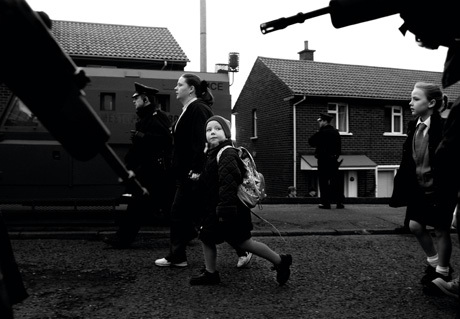Photo Insight with Cathal McNaughton
Cathal McNaughton explains the importance of shooting from your subject’s perspective and when to use black & white
 Award-winning Cathal McNaughton has more than ten years? experience covering conflicts and breaking news for national newspapers and international press agencies. He will share his best press photography and reveal how he captures a subject in ways others haven?t seen
Award-winning Cathal McNaughton has more than ten years? experience covering conflicts and breaking news for national newspapers and international press agencies. He will share his best press photography and reveal how he captures a subject in ways others haven?t seen
I took this picture during the Holy Cross dispute in north Belfast back in 2001. In short, a disagreement between adults turned ugly when loyalist protesters began preventing Catholic schoolchildren at the Holy Cross Primary School in Ardoyne, north Belfast, from getting through the front gates. The situation was the culmination of a summer of protests and occurred simply because the nationalist schoolchildren had to walk about 300 yards through a loyalist area to get to their school. Loyalists started picketing the parents as they walked their children to school, and some parents were even attacked. It was ridiculous, but more importantly, the children were terrified.
This turned into a big story at the time and news crews moved into the area while this went on for weeks. Instead of winding down after a few days, as these things tend to do, the Holy Cross situation escalated. Both sides shipped people in to protest. So you had a situation where you had loads of angry people who didn?t even live in the area or have children going to the school. Tensions were high. Police eventually arrived in riot gear to provide a corridor through which these children could walk to school. And it carried on like this without any seeming end until the 9/11 attacks occurred and knocked it off the front pages. Only then did the protests calm down.
At its peak, I walked this route with these children every school day, under armed guard from police and soldiers. I shot from every angle you can imagine, trying to find the view that best showed how crazy the situation was. You?ll notice that the schoolgirl is quite small in my frame, but the guns loom large. You can also see that the girl is making eye contact with the soldiers even though they?re out of the frame. Everyone walks to school when they?re young, but for this girl her route took her past armed soldiers and she probably didn?t understand why. It was absolutely ridiculous. This is what I wanted to show.

All these people were upset, but no one seemed to be thinking about the effect this was having on the children. What did the children think about all the screaming adults and armed soldiers? I wanted to get myself down at eye level with the girl and show the situation from her perspective, so to do this I crouched down behind the soldiers.
I shot this with two or three children walking past. I had a rough idea of what I wanted to see. I wanted to show some interaction between the child and the soldiers, but most of the time the kids looked forward. With this girl, though, there was an interaction, an exchange of eye contact that you can see between her and a soldier standing outside of the frame. To me, this adds more life to the picture. It gives it an energy that it wouldn?t have had if she were looking forward.
As I had been up and down this route so many times, I was really just covering this for myself at this stage. I had this story in mind and was shooting it in black & white because I was thinking in that mindset. It was also a little out of necessity. This, of course, was in the early days of digital photography and I was using a Kodak Pro DCS 520, an early digital camera that was a bit hit and miss at times. The colours on the DCS 520 were awful, so by converting it to black & white I was able to eliminate that distraction. Yet the monochrome also helps tie this event into the whole history of what was going on, as it harks back to the earlier pictures of The Troubles from the 1970s. It gives the picture a bit of grittiness.
I don?t shoot or think in black & white at all now. It used to be the case that you would shoot in black & white first, but when digital technology came along I found myself shooting in colour and yet still thinking of pictures in black & white because papers were still printing in mono. Now, with the advent of the internet and various multimedia, as well as colour newspapers, I shoot in colour because I?m able to. After all, the world around us is in colour. I enjoy looking at black & white photographs, but generally I shoot in colour because the colours from digital cameras are now more realistic. I want to make the most of colour now that the technology is there.
A common misconception is that people think that if something is in black & white it must be good, but bad photography is bad photography.
To see more of Cathal?s photography, or to book a place on one of his workshops and field trips, visit www.cathalmcnaughton.com



